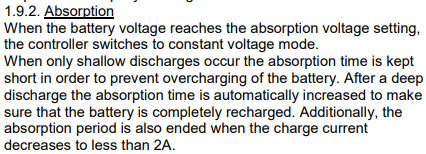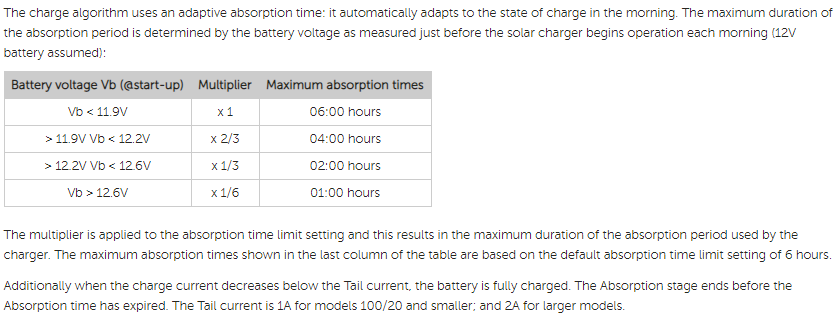I know this has been discussed alot in the forum, but my problem is my 300 watt panels can only put out max of 2 amps or so on a rainy/cloudy day. If the battery is not deeply discharged, it is possible for a few mins of brighter conditions can just barely hit absorption set point bringing controller into absorption mode, but then im back to 2amps or less max output from the panels, which results in being under the 2amp tail current and kicking me out into float. I know you cant change the tail current on the MPPT which is frustrating, but my battery is not getting charged properly because of that. what can i do? it is a lead acid battery and NEEDS proper absorption charge, and as the BMV shows, the SOC isnt even close to 100% when it goes into float. please help
- Home
- Anonymous
- Sign in
- Create
- Spaces
- Grafana
- Node-Red
- Unsupported topics
- Questions & Answers
- Modifications
- Communauté francophone
- Deutschsprachiger Bereich
- Preguntas en Español
- Explore
- Topics
- Questions
- Ideas
- Articles
- Badges
question
MPPT 100/30 exits absorption early on cloudy days. BMV reports -14Ah when goes into float
Just after a full charge cycle, maybe try to manually sync your BMV to 100% SOC to provide a fresh 'baseline' - then see how it reads on the next day. That will help understand if it's only a BMV long term Ah tracking issue or real.
Also it will only switch IF the absorption voltage setpoint is maintained while the charge current drop's below the 1A threshold. If the battery is not fully charged or very close to it, then the voltage will drop if there is not enough charge current & the phase switch should not occur.
It is possible that it's actually switching to float based on the calculated absorption time limit being reached.
If you have a read of the online manual you will find that a multiplication factor is applied to the 'max absorption time' that you specify, based on the battery voltage when the charge cycle commences. With a high battery voltage in the morning this can result in a calculated absorption time limit of only 1/6 the max time specified (so 1h for 6h max).
You could also try to increase/double the 'max absorption time' for a few days and see if this changes things. If it is really switching to float based on the current threshold then it should have no effect at all.
Also note that in the upcoming MPPT & VictronConnect firmware releases this logic will become more user configurable (including configurable tail current & the option of fixed absorption time).
Thank you for clarifying some things. I don't remember reading anything about a multiplication factor and I read the manual pretty carefully. So if I set a maximum absorption time of 12 hours, then it will change the MINIMUM actual absorption time to 2 hours instead of 1 if the start voltage is above 12.6 (for 12 volt system)? Also from all the information I read, my 100/30 amp model, the tail current is 2amps. Under 30 amp controllers were 1A. I read about Victron releasing a firmware update and I got excited, but then discovered they pulled it back. Any idea when it will be available? I would LOVE to be able to configure things more precisely since every battery system is different. In fact, just today I ended up in float again with -12Ah out of my 100Ah AGM battery still remaining on my BMV so it's very frustrating.
Firstly, sorry yes the 2A tail current threshold applies to MPPT models with a max charge current of 30A or above & 1A for all models below this.
Regarding the absorption time - even the 'calculated' absorption time is still a maximum (not a minimum), as the tail current threshold can/will still trigger the switch from absorption to float at ANY time during absorption (providing the absorption voltage threshold is also maintained).
In the actual SS 100/30 MPPT manual the logic behind the adaptive/calculated absorption time is not fully defined - it only states that an adaptive absorption time exists;

But if you refer to the online VictronConnect - MPPT manual, that document fully describes the logic;
https://www.victronenergy.com/live/victronconnect:mppt-solarchargers

Now regarding the new MPPT firmware release - v1.42 was actually just released a few days ago but it will be rolled out in stages and is not yet integrated into VictronConnect to automatically update.
If your keen, you can view the detailed change log and manually download the new firmware from the Victron Professional site, then manually update your MPPT;
https://professional.victronenergy.com
Just note that even though all the new functionality IS in the new firmware, VictronConnect has not yet been updated with the updated menu options required to configure the logic. This is still in the works and will still be a number of weeks away.
Another point is that v1.42 not only allows the tail current threshold to be user configured, but it also allows it to be totally disabled and the absorption time to be FIXED if desired (although this is typically not a good idea for lead acid based batteries).
I am EXTREMELY impressed by your reply. That was alot of specific and detailed information and I really appreciate that. I did NOT look at the VictronConnect manual and just assumed the MPPT hardware manual had the best info on the subject. It has the same "start voltage" table in regards to absorption time limit but did not talk about it's relationship to the "max limit" setting. And I totally understand that absorption can (and usually should) end as soon as it gets below tail current, but my problem was on intermittent days, the sun may come out long enough to get into absorption which starts the clock, but then isnt enough to KEEP it at the absorption set point, yet high enough that it doesnt go back into bulk. The timer continues to run, and when the sun comes back later on, you get back to your absorption voltage and then the timer expires a fews min later putting you into float, often with almost 15% capacity stranded (according to BMV which gets synced all the time). So even though the time in absorption technically was 1 hour long, the battery only stayed at 14.4 volts for maybe 10 mins, and maybe 13.7 volts or something for the rest. It sounds like Victron has listened to the community and the new firmware is the perfect answer. I will check out the manual firmware you mentioned, and if it will help Victron, i'd be happy to share my experience with it. Thanks again.
No problem, your welcome.
As you will read in the change log related to v1.42 firmware - with the new update there is also a logic change that effectively 'pauses' the absorption phase count down timer when there is insufficient solar power to maintain the absorption voltage set point.
The timer then continues again from where it left off when conditions improve and the voltage rises back up to the absorption voltage set point.
However, during this whole period (until absorption is fully completed) the MPPT will still indicate that its in the absorption phase (rather than toggling back & forth between absorption & bulk) and the daily log will include the 'total' absorption time (so its possible for the 'total' to be higher than the absorption time set).
Just looked through the changelog. All good stuff, though I didn't know it wasn't possible to rollback the firmware if there is an issue. Perhaps I should wait for Victron to sign off on it before updating. Also I don't have the SmartControl interface so I wouldnt have access to the new settings anyways until they update the VictronConnect app. Thanks again for your help.
This version has already had a fair amount of testing on a variety of systems so should be stable and it's now formally released (I'm also running it). But yes up to you, there is always some level of risk with anything new...
Ok I took the plunge. Running v1.42 as we speak. Until the VictronConnect app is updated with the extra settings, does absorption time still work as before in terms of the multiplier with max absorption setting? So that 12 hours max setting results in times given in the manual being doubled? I'm pretty sure it is, but just wanted to double check.
Risk taker.... :-)
Yes the adaptive absorption time logic remains the same by default. But you will already have the advantage of the count down timer logic updates during periods of insufficient solar power to maintain the absorption voltage set point.
So IF that was your issue/trigger then this should help.
Quick follow up question. A new version of VictronConnect app was pushed out to my laptop and iPhone this morning (7/18/19). I don't see any new settings anywhere on the MPPT 100/30 in regards to tail current, absoprtion etc. It did do an update to the bluetooth firmware, but thats it. Do I need to power cycle the hardware or something to unlock the new settings you mentioned?
Hi Todd. I can't help with the 2A tail, and I guess if your batt is quite small this could be an issue.
The easiest workaround would be just to raise your Float V target up to or near the Abs level. I'm sure you'll know to take care with that..
Bear in mind that though that Abs isn't a cast-in-stone requirement to charge batts, and even if in Bulk or Float they may still be charging well.
BMV for your SOC? Also consider the Peukert factor entered there is to compensate for a high charge rate, and if you're doing it much more gently the SOC derived may well be underestimating the true charge level of your batts. A run of short/cloudy winter days will accumulate that error.
In practice it's probably rare that BMV's are set up totally correctly, and even if they are should be synced regularly.
after spending over 200 bucks on a charge controller, I feel like I shouldnt have to "cheat" and periodically edit the float voltage, but its a valid workaround suggestion and I appreciate it. absorption IS a cast-in-stone requirement for lead acid batteries though in terms of their lifespan. a few days without it isnt a huge deal, but it needs 14.4 volts to break up sulfation which occurs during normal operation. without that, lifespan and total capacity can degrade quickly. my Peukert factor should be correct in the BMV since the values were straight from the battery datasheet. my BMV is also linked to the MPPT for accurate voltage reporting. maybe Victron should recommend a minimum battery capacity for a given MPPT charger if the tail current is going to be unchangable.
question details
11 People are following this question.
